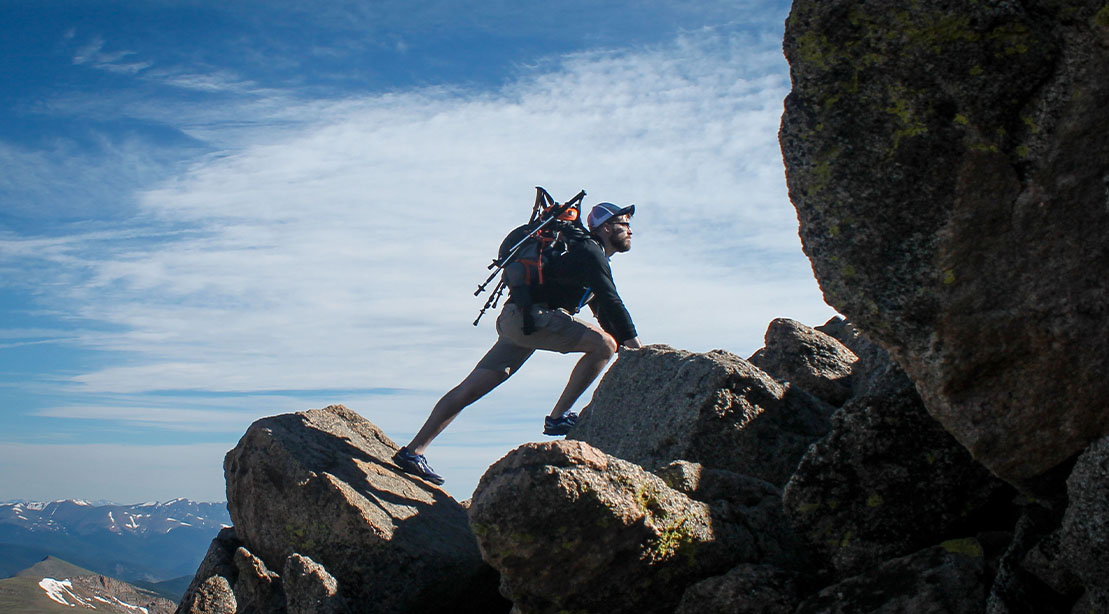Getting out in the great outdoors and admiring what it offers is a worthwhile pursuit. One excellent way to do this is hiking. Hiking is a long walk, usually on trails or footpaths in the countryside, and became popular in 18th-century Europe. Currently, hiking is enjoying a resurgence in North America as a way to get fit and as an alternative to dull long-distance cardio that’s why we’ve come up with these two hiking workouts to get you in shape to scale whatever scrambles may come your way.
The first thing many people consider when preparing for a long-distance hike is cardio. Improving and training your cardio fitness is essential not only for hiking but also for your general well-being. But strength training matters for hiking, too and should be included in your hiking workouts. If you are considering strapping on a backpack and hitting the trails, then you should be performing these hiking workouts to get you prepared for the great oudoors is for you!
Why You Should Include Strength Training In Your Hiking Workouts
Hiking is a muscular endurance activity, but that doesn’t mean hikers don’t need muscular strength. It helps to think of strength as a glass of water. The fuller the glass, the more you have to drink. What this means for you is the more muscular strength you have, the more likely you will be able to do more.
Being able to do more for longer is essential when preparing and doing a long-distance hike. Hiking over uneven terrain carrying a weighted backpack means strength training matters for several reasons, which we’ll get into now.
Better Balance: Including single-leg exercises like split squats and step-ups will help improve your balance for better stability, allowing you to take uneven terrain in stride and not fall flat on your face.
Support The Pack Better: A well-rounded strength program covering all the upper and lower back, core, and leg muscle groups will better support the backpack. Becoming stronger will go a long way, enabling you to hike longer and more robustly.
Improved Muscular Endurance: A stronger muscle will be able to do more, which is essential because, in most cases, hiking is an all-day thing. Being in good posture with a weighted backpack means you’ll be moving more efficiently, too.
Joint Health: The weight-bearing joints of the ankle, knees, and hips take a beating with hiking, and when you add a load, that truly ups the ante. Bigger and stronger muscles act like shock absorbers for your joints to help protect them.
Reduced Injury Risk: Besides common hiking hazards like heat exhaustion, heat stroke, and hypothermia, common hiking injuries include cuts, bruises, and muscle strains. Stronger muscles are less likely to strain, but there is another crucial factor why strength is vital on the trail. Major incidents like tripping, falling, and then breaking or snapping a body part or tendon are caused by fatigue.
When you’re tired, your reaction times are slower, your attention span is shorter, and you are likelier to make bad decisions. Strength training will increase your physical capacity and reduce fatigue to keep you upright longer.
Improved Enjoyment: Aches, pains, and niggles all happen on the trail. Sore knees and feet and tight muscles will suck a little bit of fun and enjoyment out of your hike. If you lack strength or cardiovascular fitness, your recovery from a day’s hike will worsen, and you will have internal battles about how tired and sore you are. When you are in better shape for your hike, you can enjoy the scenery around you, chat comfortably with your friends, and enjoy every step of your hike rather than complain.

Hiking Workouts To Get You In Shape For Your Next Adventure
Now that you know strength training should be included in your hiking workouts (and everything else), here are two two-day-a-week hiking workouts to build strength and focuses on you starting and finishing strong while hiking. You will alternate between workouts A and B for six to eight weeks before your hike.
There are two ways you perform these programs depending on time and preference. If you’re a strength training beginner, completing the six exercises in a circuit will allow more rest between exercises and provide a slight cardiovascular benefit. If you’re more experienced in the weight room, you’ll perform them as tri-sets for three to four rounds each triset.
Hiking Workout A
1A. Bodyweight Jump Squats
8-12 reps.
1B. TRX Inverted Row
8 -15 reps
1C. Unilateral Dumbbell Floor Press
6 -12 reps per side
Perform three to four rounds, resting 60 seconds between exercises and two minutes between tri-sets.
2A. Weighted Stepups
6 to 12 reps per side.
2B. Tall Kneeling Band Pull Aparts
15- 25 reps.
2C. Adductor Side Plank
3 breaths per side.
Perform three to four rounds, resting 60 seconds between exercises and two minutes between tri-sets.
Hiking Workout B
1A. Stability Ball Hip Extension Hamstring Curl
12-15 reps
1B. Split Stane Landmine Press
6 -12 reps per side.
1C. 1 Arm Rotational Cable Row
12-15 reps per side.
Perform three to four rounds, resting 60 seconds between exercises and two minutes between tri-sets.
2A. Split Squat Variation
6 – 12 reps per side.
2B. Resistance Band Reverse Flye
12-15 reps
2C. Ab Rollout
5 to 8 reps
Perform three to four rounds, resting 60 seconds between exercises and two minutes between trisets.
